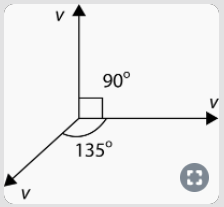At a certain height a body at rest explodes into two equal fragments with one fragment receiving a horizontal velocity of 10ms−1. The time interval after the explosion for which the velocity vectors of the two fragments become perpendicular to each other is (g=10ms−2)
1s
2s
1.5s
1.75 s
The correct Answer is:A
To solve the problem, we need to determine the time interval after an explosion when the velocity vectors of two equal fragments become perpendicular to each other. Here’s a step-by-step solution:
Step 1: Understand the Initial Conditions
The body is at rest before the explosion, meaning its initial velocity is zero. When it explodes, one fragment receives a horizontal velocity of 10m/s.
Step 2: Define the Velocities of the Fragments
Let’s denote:
- Fragment 1 (moving horizontally):
v1=10^im/s
- Fragment 2 (moving in the opposite horizontal direction):
v2=−10^im/s
However, both fragments will also experience vertical motion due to gravity. The vertical velocity of each fragment after time t can be expressed as:
- For Fragment 1:
v1y=−gt^j=−10t^jm/s
- For Fragment 2:
v2y=−gt^j=−10t^jm/s
Step 3: Write the Total Velocity Vectors
Now, we can express the total velocity vectors for both fragments:
- Fragment 1:
v1=10^i−10t^j
- Fragment 2:
v2=−10^i−10t^j
Step 4: Determine When the Vectors are Perpendicular
Two vectors are perpendicular when their dot product is zero:
v1⋅v2=0
Calculating the dot product:
(10^i−10t^j)⋅(−10^i−10t^j)=0
Expanding this:
10⋅(−10)+(−10t)⋅(−10t)=−100+100t2=0
Step 5: Solve for Time t
Setting the equation to zero:
−100+100t2=0
100t2=100
t2=1
t=1s
Conclusion
The time interval after the explosion for which the velocity vectors of the two fragments become perpendicular is 1s.
---
The body is at rest before the explosion, meaning its initial velocity is zero. When it explodes, one fragment receives a horizontal velocity of 10m/s.
Let’s denote:
- Fragment 1 (moving horizontally):
v1=10^im/s
- Fragment 2 (moving in the opposite horizontal direction):
v2=−10^im/s
However, both fragments will also experience vertical motion due to gravity. The vertical velocity of each fragment after time t can be expressed as:
- For Fragment 1:
v1y=−gt^j=−10t^jm/s
- For Fragment 2:
v2y=−gt^j=−10t^jm/s
Now, we can express the total velocity vectors for both fragments:
- Fragment 1:
v1=10^i−10t^j
- Fragment 2:
v2=−10^i−10t^j
Two vectors are perpendicular when their dot product is zero:
v1⋅v2=0
Calculating the dot product:
(10^i−10t^j)⋅(−10^i−10t^j)=0
Expanding this:
10⋅(−10)+(−10t)⋅(−10t)=−100+100t2=0
Setting the equation to zero:
−100+100t2=0
100t2=100
t2=1
t=1s
The time interval after the explosion for which the velocity vectors of the two fragments become perpendicular is 1s.
Topper's Solved these Questions
- MOTION IN A PLANEBOOK - AAKASH SERIESCHAPTER - MOTION IN A PLANEEXERCISE - EXERCISE-3 (Circular Motion)
7 Videos
- MOTION IN A PLANEBOOK - AAKASH SERIESCHAPTER - MOTION IN A PLANEEXERCISE - EXERCISE-3 (A boat in a river)
3 Videos
- MAGNETISMBOOK - AAKASH SERIESCHAPTER - MAGNETISMEXERCISE - ADDITIONAL EXERCISE
22 Videos
- MOTION IN A PLANEBOOK - AAKASH SERIESCHAPTER - MOTION IN A PLANEEXERCISE - QUESTION FOR DESCRIPTIVE ANSWER
7 Videos
Similar Questions
At a certain height a shell at rest explodes into two equal fragments. One of the fragments receives a horizontal velocity u. The time interval after which, the velocity vectors will be inclined at 120∘ to each other is
View SolutionIn the above problem, the time taken by the displacement vectors of the two fragments to become perpendicular to each other is
View SolutionAt high altitude , a body explodes at rest into two equal fragments with one fragment receiving horizontal velocity of 10m/s. Time taken by the two radius vectors connecting of explosion to fragments to make 90∘ is
View SolutionA bomb at rest at the summit of a cliff breaks into two equal fragments. One of the fragments attains a horizontal velocity of 20√3ms−1. The horizontal distance between the two fragments, when their displacement vectors is inclined at 60∘ relative to each other is (g=10ms−2)
View SolutionIn the above problem, this horizontal distance between the two fragments when their position vectors are perpendicular to each other is
View SolutionFrom a tower of height 40m, two bodies are simultaneously projected horizontally in opposite direction, with velocities 2ms−1and8ms−1. respectively.
The time taken for the velocity vectors of two bodies to become perpendicular to each other is :
View SolutionA particle of mass 4m which is at rest explodes into four equal fragments. All four fragments scattered in the same horizontal plane. Three fragments are found to move with velocity v as shown in the figure. The total energy released in the process is

View SolutionA stone is projected vertically up from the ground with velocity 40ms−1 . The interval of time between the two instants at which the stone is at a height of 60 m above the ground is (g=10ms−2)
View SolutionFrom a tower of height 40m, two bodies are simultaneously projected horizontally in opposite direction, with velocities 2ms−1and8ms−1. respectively.
The time taken for the displacement vectors of two bodies to be come perpendicular to each other is.
View SolutionA bomb of mass m is thrown with velocity v. It explodes and breaks into two fragments. One fragment of mass m', immediately after the explosion, comes to rest. The speed of the other fragment will be
View Solution
